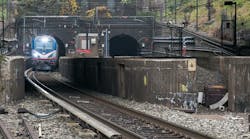OP-ED: One-year delay and budget increase for $29-billion New York Gateway Tunnel and Station Project is nothing new
Recent news announced by the Gateway Development Corporation that costs for the Hudson River Tunnel project have gone up by $275 million and the overall schedule has lost another year is nothing new. In 2015, the estimated cost for the full scope Gateway Tunnel grew by $3.9 billion, from $20 billion to $23.9 billion. In 2017, the new cost estimate grew another $5.2 billion to $29.1 billion. It continues to grow.
Construction for this project is based upon the design/build concept versus the traditional concept of bringing design and engineering up to 100 percent followed by a procurement process to hire a construction contractor.
Design-build is when you have the construction contractor advance final design beyond 30 percent in parallel with actual construction. One can only guess what the construction contractors winning bid will actually be. There is no way of knowing if the project engineers cost estimates will come in higher than the new promised $11.6 billion for two new tunnels.
Plus, there will be separate contracts for both the Portal Bridge and rehabilitation of the 100-year-old original Hudson Tunnels. If the full $29-billion project scope is funded, there will be additional contracts for construction of a new Penn Station including platforms, tracks and other activities. There are always contract change orders during construction. They are based on unforeseen site conditions or last minute changes in scope. Amtrak, the Port Authority of New York and New Jersey and Gateway Development Corporation have never shared a detailed project implementation schedule to justify any time table for start to finish of Gateway. Without this information, riders, taxpayers, transportation advocates and elected officials continue to remain skeptical.
Historically, as any major capital project advances through design and engineering, estimated project costs rise. Responses to any construction procurement can easily come in above the project engineers estimate. Any final project cost upon completion could increase based upon responses to bids, along with change orders during construction. It would be interesting to see the detailed project budget for Gateway by line item including how much money has been programmed for contingency. These dollars would pay for contract change orders during construction.
As a result of COVID-19, the world we live in has changed. Commuting patterns will be different. More people will telecommute on permanent basis. The concept of urban central business districts will continue to evolve. More people will be shopping online. More Wall Street financial institutions and major corporations based in Manhattan may continue to move additional employees to suburban back offices. There is less and less need for face-to-face meetings. Teleconference calls using zoom and other technologies are the wave of the future. New York City, especially midtown and downtown Manhattan, face a growing homeless population, decline in quality of life and increase in crime. This is making Manhattan less desirable for business, shoppers, theater and museum goers along with tourists.
Any ridership modeling for the Gateway Tunnel dealing with anticipated increase in ridership over coming decades must be reevaluated.
The Gateway Tunnel project is reminiscent of the ongoing New York Metropolitan Transportation Authority (MTA) Long Island Rail Road Eastside Access to Grand Central Terminal project. In 2001, the initial estimated cost was $3.5 billion with a completion date of 2011. In 2020, 19 years later, the estimated cost is currently $11.2 billion - based upon the 2016 MTA Federal Transit Administration amended Full Funding Grant Agreement - and could grow to $12 billion with completion in 2022. (This figure does not include other related projects called "project readiness" worth more than $4 billion more. They include Ronkonkoma branch double tracking, Main Line Third Track, Jamaica Station Capacity improvements, several thousand additional commuter parking spots, new pocket tracks and others carried off line from the official project budget).
I would not be surprised if the Gateway Tunnel project does the same and become our New York version of the infamous Boston "Big Dig."
----------------------------------------------------------
Larry Penner is a transportation historian and advocate who previously worked 31 years for the Federal Transit Administration Region 2 NY Office. This included the development, review, approval and oversight for grants supporting billions in capital projects and programs on behalf of the Metropolitan Transportation Authority, New York City Transit bus and subway, Long Island Rail Road and Metro-North Railroad, MTA Bus and NYC Department of Transportation.

Larry Penner
Larry Penner is a transportation advocate, historian and writer who previously served as a former director for the Federal Transit Administration Region 2 New York Office of Operations and Program Management. This included the development, review, approval and oversight for billions in capital projects and programs for New Jersey Transit, New York Metropolitan Transportation Authority, NYC Transit bus, subway and Staten Island Railway, Long Island and Metro North railroads, MTA Bus, NYCDOT Staten Island Ferry along with 30 other transit agencies in New York and New Jersey.



